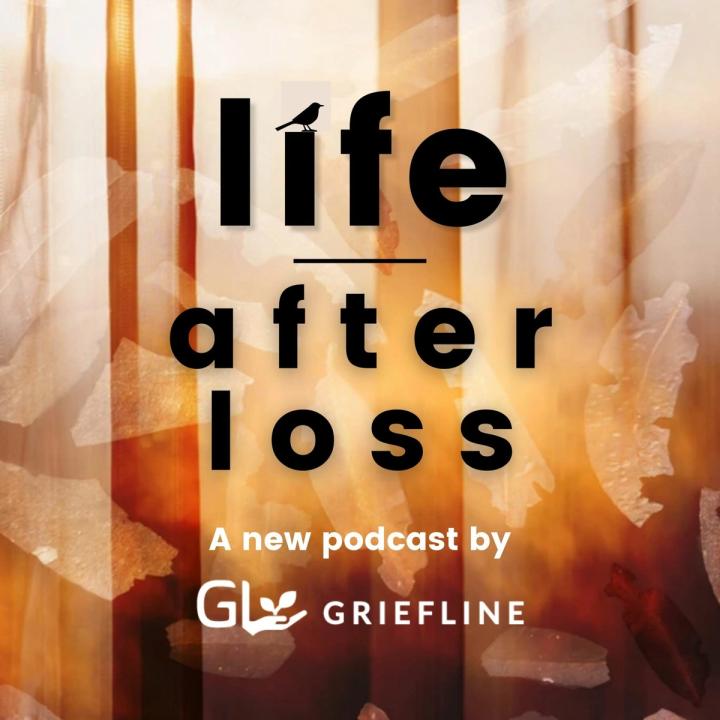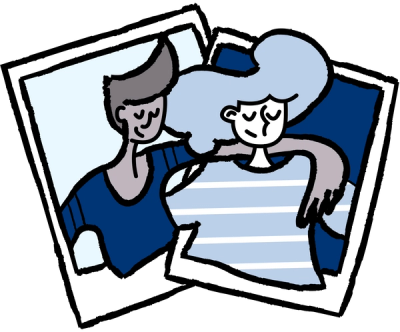Linda's story
Linda is a proud mother, grandmother, and dressmaker from Grantham, Queensland - a town devastated by floods in 2011 and again in 2022.
Despite the immense challenges of being a survivor of multiple natural disasters, Linda's resilience and determination remain steadfast. In a heartfelt and candid conversation for Griefline's Life After Loss podcast, she opens up about the emotional toll of these events and the strength that continues to carry her and her family forward.
Dr. Neimeyer, a leading expert in grief, also shares insights on how trauma and grief are connected, the role of anger in grieving, and how strategies like mindfulness and rituals can help you cope with loss.
The Life After Loss podcast is produced by Griefline. For more resources and support, please visit griefline.org.au.
Listen here
Read transcript
Note: this transcript has been edited for clarity, grammar, and flow.
Louisa Smith: Griefline acknowledges the Australian Aboriginal people as the First Peoples and traditional custodians of the land and water on which we live, work and depend. We pay respect to Aboriginal Elders past and present. We pay respect to our country, which has been protected and cared for by Aboriginal people for tens of thousands of years. We acknowledge the unique spiritual and cultural significance of land, water, and all that is in the environment to Aboriginal people and traditional custodians. We recognise their intrinsic connection to, and aspirations for, Country.
Amanda Peppard: A quick trigger warning: Life After Loss explores real-life experiences of grief, loss, and trauma. We also discuss some of Australia’s worst natural disasters and their effects on people and the environment. If you find these topics distressing or triggering, assess whether you feel supported to continue listening. Remember, the Griefline helpline is available seven days a week from 6:00 AM to midnight. You can also join our forums community or tap into our resource hub for helpful information. Go to www.griefline.org.au for access.
Louisa Smith: Life After Loss is a podcast brought to you by Griefline. For 35 years, Griefline has supported people in the community experiencing grief and loss. Over that time, tens of thousands of people have reached out to us for support and understanding via our helpline, forums, and socials. Each one of them has a story as unique as their grief experience. The one thing that unites them is a need for connection and understanding—someone to listen and validate their grief.
Amanda Peppard: This podcast gives us the opportunity to reach out to people with lived experience of grief and share courageous conversations with you. It won’t fix the grief or take away the loss, but it will help to normalise the experience—to question, inform, and challenge—and discover tangible ways to cope. Most of all, it’s an opportunity to explore how we can grow around grief and find meaning again.
Louisa Smith: Our first series focuses on natural disasters—bushfires, drought, floods—catastrophic events that are increasing in intensity and leaving a trail of visible destruction. But it’s the unseen devastation we’ll focus on—the broken hearts and minds of the people left in its wake.
Amanda Peppard: By sharing the stories of survivors, we witness their grief and learn how they’ve found ways to live each day, rediscover hope, or make meaning from their experiences, ultimately finding life after loss.
Katherine Godley: It came pretty fast. By the time I got upstairs, the wave hit the house. I was bolting up the stairs, screaming out for Michael to get his stuff upstairs. I only stopped when I got in the front door. I looked around and realised how hard it was... I put some of the babies up high. They were already struggling in waist-deep water. I put them up in a pile. Unfortunately, they died.
Speaker
The window broke, and the water started to come in. Everything else was disappearing.
Speaker
Devastating pictures of water inundating cars and homes... It’s hard to fathom how.
Louisa Smith: In 2011, Queensland was hit by floods that left 97 communities flooded or isolated and cost 36 people their lives. 2.5 million people were impacted, with damages costing more than $5 billion. December 2010 had been Queensland’s wettest on record across 107 locations, with some towns recording over 1,000 millimetres of rain. The first extreme flooding occurred in central and southern Queensland. Then, mass evacuations were ordered across central-west Queensland. The town of Theodore was the first in Queensland to be entirely evacuated by helicopter. In Emerald, 1,000 homes were submerged. Further south, the Wivenhoe Dam was overwhelmed, causing water to rush into the Brisbane River below it at an unprecedented rate. Water inundated low-lying areas of Brisbane—Suncorp Stadium was waterlogged, inner-city car parks filled with muddy water, and residents watched as their cars were swallowed by the dirty, stinking water.
But while most communities had time to prepare, the residents of Toowoomba and the Lockyer Valley weren’t so lucky when a wall of water came without warning. Emergency services described it as an inland tsunami, tearing through shops and sweeping away cars. In towns further south, residents were caught off guard and forced to climb onto rooftops, scramble up the highest tree branches, or perch on the roof of their cars. The lucky ones were winched to safety by helicopter. The town of Grantham was hit hardest. In some places, the floodwaters converged into an 8-metre-high wall, trapping people in cars and tearing children from their parents’ arms. Tractors, caravans, shipping containers, and cattle were swept away. People punched through their roofs to climb out, waiting for hours to be rescued by helicopter. Thirteen community members were lost to the deadly torrent that ravaged the town on 10 January 2011. It was said to be a one-in-100-year flood. Yet only 11 years later, it happened all over again.
Louisa Smith: So, Amanda, it’s hard to avoid the news of the recent floods in NSW and Queensland. Whether on TV, social media, newspapers, or just conversations in the street, it’s on everyone’s mind. We’re all in disbelief that this could happen again. We’ve seen so many flood events since the devastating Queensland floods of 2011, and here we are again today, having this conversation.
Amanda Peppard: That’s right. For some people, it’s happened once, twice, three times in just a matter of weeks. Just as they get back on their feet—scrubbing down walls, finding bits of furniture, getting some semblance of daily life back—the water comes again. It’s this constant retraumatisation that we’re seeing, affecting tens of thousands of people. It’s going to have serious long-term impacts on huge sections of communities.
Louisa Smith: Yes, and while some people may avoid the news because it’s too harrowing, it’s important we recognise their suffering. In doing so, we show we care and acknowledge what they’re going through. Sometimes, that’s all they need—to hold onto a bit of hope, knowing the community is behind them and there to help, even if only emotionally, as they rebuild their lives.
Amanda Peppard: Part of that is also educating people about trauma. Phoenix Australia, experts on trauma, say that any event where a person experiences or witnesses a threat to life, serious injury, or even sexual violence, has the potential to be traumatic. We all experience trauma differently, and we’ll all be emotionally affected in different ways, but with the support of family and friends, most people can recover fairly quickly. Still, the effects can be long-lasting.
Louisa Smith: Traumatic events can happen to you directly or to someone close to you. Even witnessing these events can leave us traumatised. First responders aren’t immune. Most people’s response to trauma is pure overwhelm. There’s a sense of disbelief that can make you question everything you took for granted about life, the world, and your sense of safety. Importantly, it can shake your sense of control over your destiny.
Amanda Peppard: At Griefline, we speak with many people who’ve experienced trauma—through our helpline, forums, and other services. As grief expert David Kessler, who appeared on our last episode, said: “You can have grief without trauma, but you can’t have trauma without grief.” In this episode, we’re exploring traumatic grief. It’s different from the grief experienced after losing a loved one to natural causes and requires a different therapeutic approach. We think it’s an important and timely topic, and we’re pleased to bring you this episode.
Dr Robert A. Neimeyer: We have that element of an eruption—something incomprehensible, uncontrollable, far beyond our ability to manage. That is the very definition of trauma. And then we have the loss of that which we once held dear—sometimes the person we once had, sometimes the home, the business, the city we once had.
Amanda Peppard: Dr Robert A. Neimeyer is Professor Emeritus of the Department of Psychology at the University of Memphis. He maintains an active consulting practice and also directs the Portland Institute for Loss and Transition, which provides global online training in grief therapy. Dr Neimeyer has published 30 books, including Techniques of Grief Therapy and Bereavement and Beyond, and serves as editor of Death Studies. He’s the author of over 500 articles and chapters and is a popular workshop presenter. He’s currently working to advance a more adequate theory of grieving as a meaning-making process. In recognition of his contributions, Dr Neimeyer has been made a Fellow of the American Psychological Association and received Lifetime Achievement Awards from both the Association for Death Education and Counselling and the International Network on Personal Meaning.
Welcome, Dr Neimeyer, to the Life After Loss podcast. We feel very privileged to have you here. Your research into meaning reconstruction in bereavement is regarded highly by grief and loss practitioners worldwide. Perhaps you could explain this theory to our listeners, many of whom know grief through lived experience.
Dr Robert A. Neimeyer: Well, of course, that makes them the true experts, doesn’t it? When we ourselves suffer the rigours of tragic loss, we come to know what grief is—and also what it isn’t. It’s not a simplistic movement through predefined stages of adaptation. It’s a much more elemental experience, much more visceral, often tumultuous, emotional, and incomprehensible. We’re trying to make sense of what we’ve been through, and we’re trying to make sense of who we are in light of it. So, with that in mind, I try to understand grieving as a process of meaning-making. A core aspect of grieving has to do with reaffirming or rebuilding the world of meaning that’s been challenged by loss—shaken, sometimes shattered by it. That’s the theme we’re generally operating under: to understand grief as an existential passage through a universal experience of loss. Loss will touch all of us, multiple times in the course of our lives. Sometimes lightly, sometimes more aggressively. For those listeners who’ve been through difficult losses, I want to honour their humanity and recognise the considerable difficulties that such grief introduces into our lives, and urge them to take in the helpful and human messages you offer.
Amanda Peppard: Thank you, Bob. What’s been happening lately with the floods has affected so many Australians. People have lost homes, livelihoods, and, of course, loved ones. But at the same time, they’ve experienced traumatic situations—being airlifted to safety, homes filling with water, being swept away. All of these traumatic experiences have occurred alongside the losses. We hear a lot about PTSD in situations like this. Do you see a connection between grief and trauma that we don’t hear enough about?
Dr Robert A. Neimeyer: We don’t hear enough about it, particularly in cases like this, where people are standing at the junction of exactly these two things. The world has been traumatically taken from them. We have that element of an eruption of something incomprehensible, uncontrollable, far beyond our ability to manage—that’s the very definition of trauma. And then we have the loss of that which we once held. Sometimes the person we once had, sometimes the home, the business, or the city we once had. I’ve visited Brisbane many times, both before and after the 2011 floods, and you can see the residual damage to the city and many of its inhabitants. It is a horrific experience.
Amanda Peppard: Linda Godley is a dressmaker, an avid photographer, and a proud mum of three adult children. A self-described Aussie battler, she lives in Grantham with her husband, Gary, their eldest son, Michael, and daughter, Katherine. Until the recent floods, their son Jack lived just a stone’s throw away with his wife and young kids. The Godleys are a sporty family who love the outdoors—whether riding dirt bikes, camping, bushwalking, or spending time together on the deck of their modest mid-century house situated on the flood-prone plains of Grantham.
In 2011, the family lost every single photograph and almost all their possessions to the floods. Katherine, who was only 14 at the time, witnessed what no child should ever see when an inland tsunami took her horses and three precious human lives. The family was left devastated and traumatised and was forced to declare bankruptcy, but their resilience saw them pull together to rebuild their home. Linda and Katherine began designing and creating fantasy costumes for horses and their riders. In early 2022, Linda was excited to reveal a little piece of paradise to her two grandsons—a finished garden complete with a children’s playground, a rotunda for her and Gary to watch them play and splash in the pool, and fairy lights in the trees.
Unfortunately, the garden was washed away in the floods of March 2022, before the boys ever got a chance to play in it. Once again, the Godleys were wiped out. This time, Katherine was determined not to lose her horses, so she and Gary held onto them, standing ankle-deep in floodwaters for a full 24 hours before emergency services agreed to help. Jack also lost his young family’s home and had to move away to Brisbane. Now, like scores of other flood survivors, the Godleys have little chance of selling their property and moving to higher ground, leaving Linda feeling overwhelmed by the mammoth task ahead and fearful it could happen again.
We’re truly grateful to Linda for sharing her story with us on the Life After Loss podcast.
Amanda Peppard: Welcome, Linda, to the Life After Loss podcast. We understand that you’ve experienced floods—twice—at a level that most people would never imagine. We’re honoured you’ve joined us today to share your experience and help raise awareness about what happened to you, your family, and your community. Could you tell us what it was like when the 2011 flood first hit?
Linda Godley: Oh, 2011... it was just such a shock. My husband, one of our sons, and I were actually in Sydney for a soccer tournament. Katherine was supposed to come; she had her bags packed by the door. But at the last minute, she decided to stay home to look after her animals. We’ve got a bit of a zoo here, and she wanted to make sure everything was alright. We thought, “Fine, that’s OK, your choice.” We dropped our son at camp, did some shopping, and then we got this phone call. You’ve never heard anything like it—Katherine was screaming down the line. We couldn’t make out what she was saying. We had to get her brother on the phone to tell us what was happening, and he said, “Everything’s gone, Mum.”
Linda Godley: It was horrific. We could hear our daughter, and she was just beside herself. Our horses were further up the road, and they were swept away by the torrent. There was nothing we could do. We had all three of us on the phone, calling everyone we knew, trying to get help, trying to get someone to get the kids out. But there was nothing anyone could do. Too many trees. The helicopters couldn’t come, no one could get in. We were so far away, and we felt absolutely helpless. Then, we heard about a second wave, and it was already ten feet high. We were just in a panic.
Katherine had no communication except with us on the phone, and my husband was desperate to get back. Qantas held the last flight from Sydney open for him, and we raced to the airport. He got on the plane with nothing but the clothes on his back—no luggage, no possessions. When he landed, his sister picked him up, but even then, they couldn’t get through for days. Eventually, they were evacuated. Katherine, bless her, managed to save ten animals. She sat outside in the rain with them. We could hear her on the phone, going into shock. The authorities wanted to take her to hospital, but we said no—they couldn’t separate her from what she had just lost. She needed to stay with the animals until my husband could get to her.
It took a week before he reached her, and by that time, she’d gone through something no child should ever have to face. She didn’t have her parents with her. She had to handle it all alone.
Amanda Peppard: Linda, when you finally saw Katherine after going through all of that, what was it like for you?
Linda Godley: It was a huge relief. I’m going to cry... It was just such a relief to be back with them. To have them in my arms again. It’s not right for kids to go through something traumatic like that without their parents. It’s just not right. When something awful happens, they need their mum and dad. It’s so wrong that she had to face it alone.
Louisa Smith: What was the hardest thing to deal with after the initial floods in 2011?
Linda Godley: The loss—it was unbearable. You think you can’t get over it. To this day, I still can’t believe my kids don’t have photos of us as babies. They don’t have our wedding photos. Our grandchildren will never see those moments. They won’t have anything to compare, no photos to look back on. You can lose a dining room table, and sure, you can replace that. But you can’t replace those memories. I was a bit of a photo fanatic, you know? One photo can bring back an entire day’s memories. That’s all gone.
I’d kept all the best baby clothes, too. I made all my kids’ clothes, and I saved the very best for my grandchildren. That never happened. All the little sentimental things like cutlery and keepsakes—those are gone too. Our son lost all his things, and while Katherine was upstairs and didn’t lose her personal possessions, she lost all her horse gear. And of course, her horses.
Katherine Godley: During the night, we heard two people yelling for help. One of them kept calling for his dad. I yelled back to him, telling him we couldn’t reach him yet but we’d be there as soon as the water went down. We kept yelling back and forth to make sure we were all still there. He was scared, kept calling out to his dad. If he had let go of that tree, he’d have been gone, just like his dad.
There was another family nearby. They had a dog with them on the roof. They just sat there all night in nothing but the clothes they were wearing. I think they had a torch, and that was it.
Louisa Smith: Linda, how did you, as a family, support Katherine in the months and years following such a traumatic experience?
Linda Godley: It was really hard. Katherine had a lot of bad days, and we always told her it was OK to have those days. We said to her, “You don’t have to forget. We don’t want you to forget, but you have to keep moving forward.” Life keeps going. A lot of bad things happen to people—some worse than what we went through. But you have to keep going. You have to keep battling on.
It took a long time to get through it. People don’t understand. They say hurtful things, like, “Why don’t you just move? It’s time to get out of there.” How do you respond to that? How do you just move when you’re stuck? We’ve been here for generations. They knew about these flood risks over 100 years ago, but nothing was done to stop it. It’s not our fault this happened. It’s the council’s fault for allowing it, and they should be responsible for fixing it.
Dr Robert A. Neimeyer: There’s often reason to feel hard done by, unfairly treated, or unprotected by those who should have kept you safe. But one thing to understand is that anger can serve as a protective emotion. It shields us from the vulnerability that lies beneath it, like helplessness and grief. Anger energises us, and sometimes it’s easier to hold onto than the deep pain underneath.
When I work with clients, I listen for those other emotions. Anger often masks something deeper. I might ask, “What does your anger need?”—the answer might be justice or protection. Then I’ll ask, “What does your grief need?”—and often, it’s consolation, safety, or understanding. Both emotions are valid and adaptive, but they signal different needs. Listening to both is key to understanding how to move forward through adversity.
Linda Godley: It’s really overwhelming. I’m trying to stay positive, but my husband is convinced that nothing will change, that we’ll be stuck here forever. I’m trying to believe there’s someone out there who can help us move somewhere safer. We’re fixers by nature—when something breaks, we fix it. But this time, it’s out of our control. We can’t fix this.
Amanda Peppard: What feelings have been coming up for you and your family since the second round of flooding? I can only imagine that a whole range of emotions have surfaced—are some stronger than others?
Linda Godley: I think the hardest part is not knowing our future. Even though we still have our house, it’s damaged. There’s no point in fixing anything because we don’t know what’s going to happen. We’re the kind of people who don’t like things lingering—we get on with it, we fix things quickly. But now, there’s no point doing anything. We’re just living day-to-day, going to work, but with no future in sight. What’s the point of working hard to make something beautiful if it could all be gone tomorrow?
It’s exhausting. You don’t sleep properly, you’re physically drained. Your back aches, you get infections from cuts because the water’s toxic—it’s not just rainwater, it’s filled with chemicals. Even the smallest cuts can turn into infections. Katherine got ringworm. You have to take care of yourself and be really cautious—wear gloves, clean everything thoroughly. These are the hidden things people don’t realise come with surviving a flood.
Louisa Smith: It sounds like you and your family have an incredibly strong dynamic. From the outside, it’s clear that you’re a solid unit. You all seem to draw strength from each other.
Linda Godley: We try to stay positive. I love our family. I love what we’ve always had. We were always improving our lives, moving forward, and we loved doing that as a family. I’m hopeful that we’ll get back to that someday. But for now, we just take things one day at a time.
Louisa Smith: You are incredibly courageous, Linda. We’re so grateful that you’ve taken the time to share your story with us and with the wider podcast community. We’ll keep in touch and keep sending you and your family all our love and hope for a safer future.
Dr Robert A. Neimeyer: Sometimes it’s about finding small ways to ground ourselves in the present moment—focusing on the little things, like a breeze, the taste of a meal, or the sound of the ocean. These moments bring us back to the world around us, which still holds beauty and meaning, even in the face of grief. Creativity, too, can help. Whether it’s making art, music, or simply finding something that matters to you and allows you to move forward, these things can reignite a spark within us.
We are not just shells of who we once were. There’s still life and hope, even if it feels far away. Anything that brings us back into the world, that expands our perspective beyond the pain, helps us revise a world that has been shaken by loss. Mindfulness, creative expression, and staying present are all ways to begin rebuilding a life that has been altered by grief.
Louisa Smith: What struck me most from our conversation with Linda was how much she has learned from the floods in 2011, especially the importance of staying strong as a family. Her priority is making sure that they are all safe, supported, and capable of facing whatever comes next. And, incredibly, they faced it again in 2022, applying those hard-learned lessons. They’ve shown resilience by setting daily tasks and focusing on one thing at a time—cleaning one room, then the next. That sense of purpose and structure is so vital in the midst of chaos.
And then there’s self-care—taking the time to rest, eat well, and tend to wounds. Simple, but powerful. Linda seems to be channelling her anger into determination and purpose. Her grandchildren are a driving force for her. She’s holding onto hope for a better, safer future for them. Her husband might not be in that same hopeful space, but grief is such an individual journey, isn’t it? Each of them will have to find their own way through this.
Amanda Peppard: What I found fascinating was how they reclaimed their lives after the 2011 floods by tapping into their creativity. Linda and Katherine designed and made fantasy costumes for horses and their riders—a beautiful bonding experience. Creative outlets can be incredibly important for recovery. And equally, spending time in nature helped them heal. They’re a sporty, outdoorsy family, and those activities don’t cost a thing. They live in such a beautiful part of the world, and you can tell they still love and respect their environment, despite everything they’ve been through.
Louisa Smith: Yes, and I think what we see in this episode, with our focus on traumatic grief, is that it’s a very different kind of grief compared to what we usually deal with at Griefline. Grief from natural causes, like losing a loved one, is always difficult, but traumatic grief brings an extra layer of complexity. There’s a loss of control—a dashing of beliefs about how the world works. When you’re hit by something like these floods, not once but twice, you have to come to terms with the fact that you have no control over what happens next. That’s a terrifying reality.
Louisa Smith: Absolutely. From what Linda shared, it’s clear that the repeated events have left her family with deep fear and uncertainty. How do you cope with the possibility that it could happen again? It’s unfathomable for most of us. To live through such devastation, not just once but twice... And yet, here Linda is, still going. She’s an inspiration to all of us, as are the many people recovering from these floods, just pushing forward each day, living life as best they can.
Amanda Peppard: Yes, Linda is what you’d call an everyday hero. She’d probably never let us say that to her face—she’s far too humble. But she is. She’s just a battler, pushing through because she believes that’s the only way forward.
Louisa Smith: Absolutely. We are so grateful to Linda and her family for sharing their story with us today, and we also thank Dr Robert Neimeyer for his incredible wisdom. It’s been a remarkable journey exploring traumatic grief and really getting into the heart of what it feels like to experience something so devastating as rising floodwaters, which can sweep away lives, homes, and dreams.
Amanda Peppard: Thank you for joining us on the Life After Loss podcast, brought to you by Griefline. Through courageous conversations like this one, we continue to normalise grief and loss as a universal human experience, and demonstrate that through sharing lived experiences, we can learn, adapt, and find life after loss.
Don’t forget to visit the Life After Loss page on our website, where you’ll find photos, links, videos, and more information on our guests, as well as bonus interview content and additional resources. If this podcast raises any issues for you, please call the Griefline Helpline at 1300 845 745, available any day of the year between 6:00 AM and midnight. Or visit our website at www.griefline.org.au, where you can find online forums, expert advice, and helpful resources.
And remember—you are not alone.
Resources
Robert A. Neimeyer, PhD:
- www.portlandinstitute.org
- Facebook @PortlandInstitute / Twitter @PortlandLossRead
- Book: New Techniques of Grief Therapy (Series in Death, Dying, and Bereavement), 2021
- Journal: Death studies through Taylor & Francis
Thanks to Amanda Gearing, Author and Interviewer of Katherine Godley, 2011. 28510, Amanda Gearing Queensland Flood Collection, John Oxley Library, State Library of Queensland.
The Torrent: A true story of heroism and survival, 2nd edition. (2017, January 29). UQP.
Linda Godley Facebook @lindagodley
Credits
This episode of the Life After Loss podcast was brought to you by Griefline thanks to the NAB Foundation Community Grants Program.
- Co-Hosts – Louisa Smith and Amanda Peppard
- Original Music – Tilly Vickers-Willis
- Audio Engineer – Daryl Missen, Purple Wax www.purplewax.com.au
- Creative Producer – Amanda Peppard






